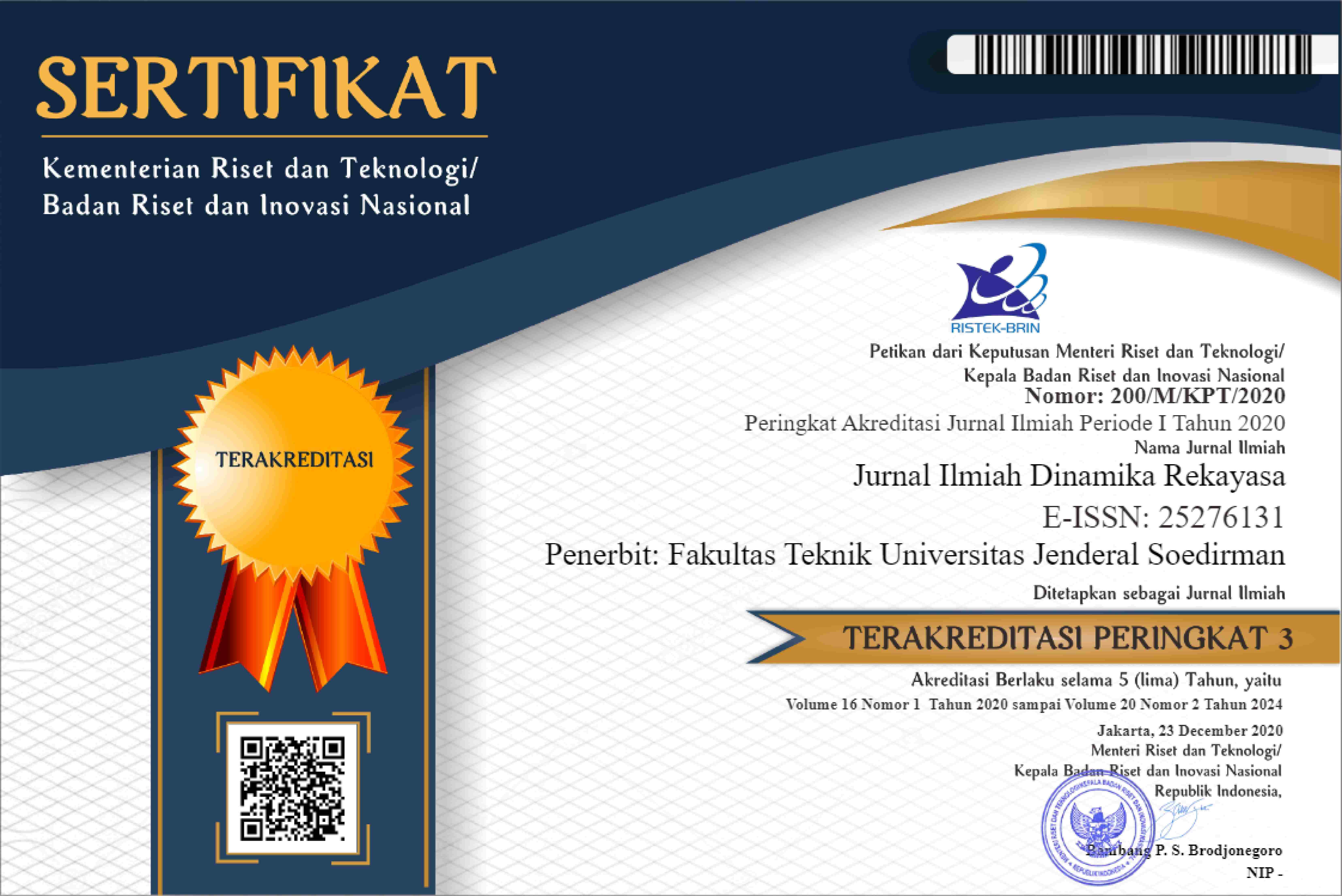Author Guidelines
Introduction
Jurnal Ilmiah Dinamika Rekayasa with registered number p-ISSN: 1858-3075, e-ISSN: 2527-6131 is a scientific journal published by Engineering Departement of Jenderal Soedirman University. Jurnal Ilmiah Dinamika Rekayasa is a peer-reviewed national journal in Indonesian, published two issues per year (February and August). Jurnal Ilmiah Dinamika Rekayasa is to publish high-quality articles dedicated to all aspects of the latest outstanding developments in the field of engineering. Its scope encompasses the engineering of signal processing, electrical (power), electronics, instrumentation & control, telecommunication, Computing and informatics, Geological Engineering, Civil Engineering and Industrial Engineering
The Guidelines for The Manuscript Body Text
Scientific articles will be published in the Jurnal Ilmiah Dinamika Rekayasa must follow the rules of writing on the paper body. The rules follow the pattern of IMRAD (Introduction, Method, Result, and Discussion) added the last section is the closing remarks section .
- Title: The title should be concise and indicate the identity of the subject, the research objectives, and keywords. A length of about 5-15 words with font size 18.
- Author name:Â The author's name without academic degrees and not preceded by the word "by" followed by the name of the institution, address of institution and contact email.
- Abstract and Keyword:Â Abstract wrote in Indonesian and English up to 250 words. Keywords that included 3 to 5 keywords.
- Introduction: basically, the introduction provides background research, literature review, originality of research, and research objectives.
- Method: In the methods, the section provides a summary of the methods used, such as the subjects studied, tools and materials used, model or design used, sampling technique, the measured variable, analysis, and statistical models used.
- Result: In the results, the section contains the presentation of the results of the research that can be illustrated using tables or figures to clarify the presentation of the results verbally.
- Discussion: material discussion mainly concerned, whether the results are consistent with the hypothesis or not, and put forward the argument.
- Closing Remarks:Â the closing remarks section contains the conclusion of the research that has been done and future works.
The Guidelines for Citations and References
Style referral source citations in Jurnal Ilmiah Dinamika Rekayasa using the IEEE style modified. It is advisable to use reference management software such as Mendeley, EndNote, Zotero, and others.
The Manuscript General Guidelines Â
The paper was written by using the following template. Writing papers based on the following rules :
- The length of manuscripts between 6-10 pages, using A4 paper size.
- The left margin is 3 cm, the right margin is 2 cm, top and bottom margins are 2.5 cm.
- The text is single-spaced; uses a 10-point font; Times New Roman font type.
- Writing in the images, tables, attachments using Times New Roman 8-point and single-space
DOWNLOAD MANUSCRIPT TEMPLATE
Copyright Notice
Authors who publish with this journal agree to the following terms:
Authors retain copyright and grant the journal right of first publication with the work simultaneously licensed under a Creative Commons Attribution License that allows others to share the work with an acknowledgement of the work's authorship and initial publication in this journal.
Authors are able to enter into separate, additional contractual arrangements for the non-exclusive distribution of the journal's published version of the work (e.g., post it to an institutional repository or publish it in a book), with an acknowledgement of its initial publication in this journal.
Authors are permitted and encouraged to post their work online (e.g., in institutional repositories or on their website) prior to and during the submission process, as it can lead to productive exchanges, as well as earlier and greater citation of published workÂ
Privacy Statement
The names and email addresses entered in this journal site will be used exclusively for the stated purposes of this journal and will not be made available for any other purpose or to any other party.





